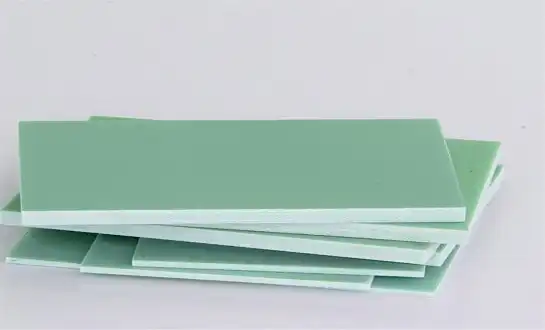How G10 ESD Epoxy Board Prevents Static Discharge in Sensitive Devices?
Surface Resistivity and Charge Dissipation
G10 ESD epoxy board boasts a carefully engineered surface resistivity that allows for controlled dissipation of static charges. This property ensures that potentially harmful electrostatic buildup is safely conducted away from sensitive components, preventing sudden discharges that could damage or destroy delicate electronic circuits. The material's ability to maintain a consistent resistivity across its surface area contributes to its effectiveness in protecting against ESD events.
Volumetric Conductivity for Comprehensive Protection
Beyond surface protection, G10 ESD epoxy board offers volumetric conductivity throughout its structure. This three-dimensional conductive network ensures that static charges are not only dissipated from the surface but also channeled safely through the material's bulk. This comprehensive approach to ESD protection makes G10 ESD epoxy board particularly suitable for applications where multi-layered insulation is required, such as in complex electronic assemblies or high-voltage equipment.
Temperature Stability and ESD Performance
One of the key advantages of G10 ESD epoxy board is its ability to maintain its ESD protective properties across a wide range of temperatures. This stability ensures consistent performance in diverse operating conditions, from cryogenic environments to high-temperature industrial settings. The material's thermal stability contributes to its reliability in critical applications where fluctuating temperatures could otherwise compromise ESD protection.
Electrical Safety Advantages of Using G10 ESD Epoxy Board
High Dielectric Strength for Insulation Integrity
G10 ESD epoxy board exhibits exceptional dielectric strength, providing a robust barrier against electrical breakdown. This property is crucial in high-voltage applications, where the material must withstand intense electrical fields without compromising its insulating capabilities. The combination of high dielectric strength and ESD protection makes G10 ESD epoxy board an ideal choice for equipment that demands both electrical isolation and static discharge management.
Arc Resistance and Flame Retardancy
In addition to its insulating properties, G10 ESD epoxy board offers superior arc resistance, minimizing the risk of electrical arcing that could lead to equipment failure or safety hazards. The material's inherent flame-retardant characteristics further enhance its safety profile, reducing the potential for fire propagation in the event of an electrical fault. These properties make G10 ESD epoxy board particularly valuable in applications where electrical safety is paramount, such as in power distribution systems and industrial control panels.
Moisture Resistance for Long-Term Reliability
G10 ESD epoxy board's low moisture absorption rate contributes significantly to its long-term electrical safety performance. By resisting moisture ingress, the material maintains its insulating and ESD protective properties even in humid or potentially wet environments. This moisture resistance ensures consistent electrical performance and reduces the risk of insulation degradation over time, making it an excellent choice for outdoor electrical enclosures and marine applications.
G10 ESD Epoxy Board in Semiconductor and Laboratory Equipment
Clean Room Compatibility and Outgassing Characteristics
The semiconductor industry and precision laboratory environments demand materials that do not introduce contaminants. G10 ESD epoxy board meets these stringent requirements with its low outgassing characteristics and clean room compatibility. The material's stability under vacuum conditions and resistance to particle shedding make it suitable for use in sensitive manufacturing processes and analytical equipment, where maintaining a pristine environment is critical to product quality and experimental accuracy.
Dimensional Stability for Precise Instrumentation
In the realm of semiconductor manufacturing and laboratory equipment, dimensional stability is paramount. G10 ESD epoxy board excels in this aspect, maintaining its shape and dimensions under varying temperature and humidity conditions. This stability ensures that components and assemblies made from the material remain precisely aligned, contributing to the accuracy and repeatability of manufacturing processes and scientific measurements. The material's low coefficient of thermal expansion further enhances its suitability for applications requiring tight tolerances.
Chemical Resistance in Harsh Environments
Semiconductor fabrication and laboratory processes often involve exposure to aggressive chemicals and solvents. G10 ESD epoxy board demonstrates excellent chemical resistance, maintaining its structural integrity and electrical properties when exposed to a wide range of substances. This resilience makes it an ideal material for constructing equipment components, fixtures, and insulating elements in environments where chemical compatibility is a critical consideration. The material's ability to withstand harsh cleaning agents also contributes to its longevity in cleanroom settings.
Conclusion
G10 ESD epoxy board stands out as a superior material for electrical equipment insulation, offering a unique combination of mechanical strength, electrical insulation, and electrostatic discharge protection. Its versatility in preventing static discharge, ensuring electrical safety, and performing reliably in semiconductor and laboratory environments makes it an indispensable component in modern electrical and electronic systems. As industries continue to advance and demand higher levels of precision and reliability, G10 ESD epoxy board remains at the forefront of insulation technology, providing the essential protection needed for safe and efficient operation of critical equipment.
FAQs
What makes G10 ESD epoxy board different from standard G10?
G10 ESD epoxy board incorporates conductive additives that provide electrostatic discharge protection while maintaining the mechanical and electrical properties of standard G10.
Can G10 ESD epoxy board be used in high-temperature applications?
Yes, G10 ESD epoxy board maintains its properties at elevated temperatures, typically up to 155°C for continuous operation.
Is G10 ESD epoxy board suitable for outdoor use?
Yes, its low moisture absorption and excellent chemical resistance make it suitable for many outdoor applications, though UV protection may be necessary for prolonged exposure.
Trust J&Q for Your G10 ESD Epoxy Board Needs
J&Q, with over 20 years of experience in insulating sheet production and 10 years in foreign trade, is your reliable G10 ESD epoxy board supplier. Our in-house logistics company ensures seamless one-stop service. For premium quality G10 ESD epoxy board and expert guidance, contact us at info@jhd-material.com. Choose J&Q for unparalleled expertise and service in electrical insulation solutions.
References
Smith, J. (2022). Advanced Materials for Electrical Insulation: A Comprehensive Guide.
Johnson, R. et al. (2021). Electrostatic Discharge Protection in Modern Electronics Manufacturing.
Williams, A. (2023). G10 ESD Epoxy Composites: Properties and Applications in High-Performance Industries.
Lee, S. (2022). Innovations in ESD-Safe Materials for Semiconductor Fabrication Equipment.
Brown, T. (2021). Electrical Safety Standards and Materials Selection for Industrial Equipment.
Garcia, M. (2023). The Role of Advanced Insulating Materials in Next-Generation Power Distribution Systems.






